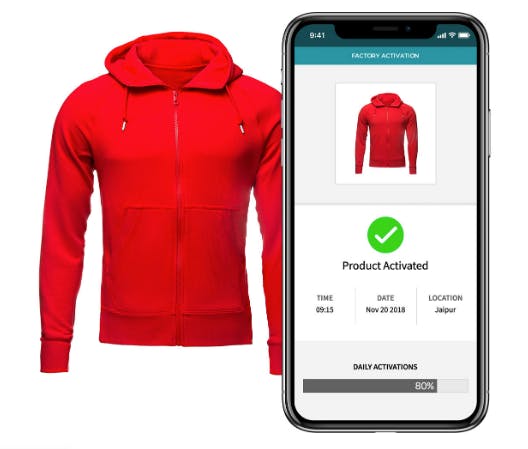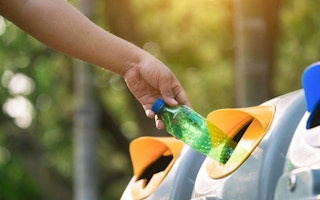One of the main reasons why global recycling rates are so low—just 20 per cent of the world’s plastic is recycled—is because people simply do not know how to recycle.
Too often, people throw non-recyclable stuff in with recyclables, unaware that this derails the whole process. Waste that has not been separated arrives at recycling plants and recyclers struggle to sort out what they can use from what they can’t.
But what if there was a system that made it easy to distinguish recyclables from non-recyclables? What if the lifecycle of every consumer product could be tracked, from factory to recycling plant?
This is now possible because products can be connected to the internet. And if a London-headquartered software startup called EVRYTHNG gets its way, pretty soon every product made and sold will carry a new type of barcode.

A product tagged by EVRYTHNG
On that barcode is a unique web address for the product. When a consumer or recycler scans the barcode using a smartphone, they can get all sorts of information on the product from the web identity that is stored in the cloud, from where it was made and who made it, to the materials it is made from, and how to recycle it—a sort of LinkedIn profile page for consumer goods.
Knowing the origins of packaged products is crucial to tackling the plastic pollution crisis, says Niall Murphy, the founder and chief executive of EVRYTHNG, which counts fizzy drinks brand Coca-Cola and packaging giant WestRock as customers, and has offices in London, San Francisco, New York, Zurich and Singapore.
To respond to the plastic crisis, plastic producers “either have to provide organic based packaging, which composts itself, or have innovate so that packaging can become returnable—and that means that it has to be traceable,” Murphy says.
“
Consumers may care less about the sustainability of a product in Asia, but they do care about authenticy and wellbeing.
Niall Murphy, founder and chief executive, EVRYTHNG
In this interview with Eco-Business, the tech entrepreneur talks about why companies should care about the traceability of their products, why digital labelling will take off in Asia, and the impact EVRYTHNG could have on the circular economy.
In a nutshell, how does EVRYTHNG work?
There are 4 trillion consumer products made and consumed every year. EVRYTHNG works with consumer product makers to put a tag on every physical product, from a can of Coke to a t-shirt.
The system works in three stages:
1. The consumer scans shopping receipts to import purchased products into a mobile app.
2. Through the mobile app, consumers can access information on where, when and how to recycle the different parts of each product based on local available infrastructure.
3. Consumers can then recycle items in street bins or preferred recycling centres. They can earn rewards by registering where they are recycling by scanning or tapping identity tags on recycling units.
Rewarding the consumer for recycling is really important, and they can post their recycling activity in social media. The programme also provides product information on what is being recycled back to the recycling firm.
How has EVRYTHNG been deployed so far?
The first app was launched at Carrefour supermarkets in Spain is called Reciclaya. It allows customers to determine how to recycle products by simply scanning the barcode on their supermarket receipt. More specifically, the app separates products into virtual recycling bins so that customers can place them in the nearest appropriate containers.
How will your technology have an impact in Asia?
It will for two reasons. First, because there’s a huge amount of supply chain production that comes from China and Southeast Asia. Second, because engagement between smartphone users and the physical world is higher in Asia than anywhere in the world. Last year, US$1.5 trillion was transacted in mobile payments through WeChat, for example.
When companies look at where they can make the most impact [in reducing their environmental footprint] it is Asia. Corporates are faced with significant challenges in their global supply chains, for instance, the counterfeiting of high value consumer goods, and a lot of those problems come from Asian markets. Transparency over the provenance of products can help address those issues.
Not everyone, particularly in developing markets, has a smartphone to scan a product for product or recycling info. How will you get around this reality?
Yes, this is of course a practical issue. But there are other ways of getting the information to consumers through scanners in stores—for instance, holding a product in front of a screen to get information about it.
To what extent do you think that consumers will care where products come from, particularly in Asia where sustainability is not as big an issue as in Europe?
Consumers may care less about the sustainability of a product in Asia, but they do care about authenticity and wellbeing. Global brands have liability in Europe and the US for practices they deploy in emerging markets. So part of this is consumer demand, but the other aspects are business accountability demands and taxation on landfill.
How do you ensure that the digital links can’t be forged and that the information given is genuine and accurate?
The unique identities provided for individual products are crypto-secure credentials. But obviously a QR code can be photocopied and therefore replicated. By being connected to a digital identity on the web we can detect duplications rapidly and therefore flag all products associated with that identity as suspect.
How long will it take before every consumer product has these digital links, and what do you see as the obstacles in the way of that happening?
Realistically it’s going to take two to three years for roll-out. Barriers include investment by packaging companies in digitally serialised printing for packaging, and upgrades to point of sale software by retailers.
Just as the technology behind blockchain uses an enormous amount of energy, have you looked into the energy footprint of the system for powering EVRYTHNG technology?
EVRYTHNG uses real-time analytics technologies in the cloud that are significantly more cost effective than Blockchain by several orders of magnitude. The reason Blockchain is so energy consuming is the huge amount of effort that goes in to mining and replicating transactions, neither of which are factors in realtime analytics systems like ours.
However, there is clearly energy consumed to manage data digitally about product items. What’s needed is a full cost analysis taking into consideration savings in materials, transport and waste. That kind of analysis across the full physically and digital lifecycle of a product has not been done, but I think would be very valuable.

















